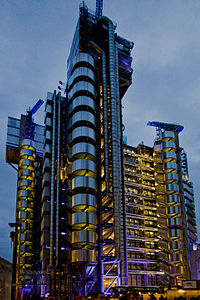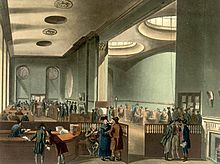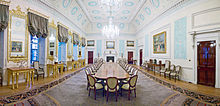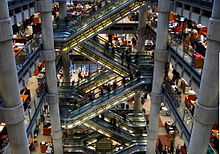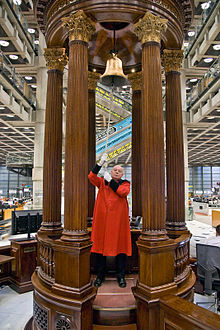- Lloyd's of London
-
- "Lloyd's" redirects here. For other uses, see Lloyd
Lloyd's Type Insurance market Industry Insurance
ReinsuranceFounded 1774
(Society of Lloyd's)
1871
(Incorporation of Lloyd's)Founder(s) Edward Lloyd Headquarters 1, Lime Street
London, United KingdomKey people Lord Levene
(Chairman)
Richard Ward
(Chief executive officer)Website lloyds.com Lloyd's, also known as Lloyd's of London, is a British insurance and reinsurance market.[1] It serves as a partially mutualised marketplace where multiple financial backers, underwriters, or members, whether individuals (traditionally known as Names) or corporations, come together to pool and spread risk. Unlike most of its competitors in the insurance and reinsurance industry, it is not a company, but it is a corporate body under the Lloyd's Act 1871 of the British Parliament. Uberrimae fidei (Latin for "of the utmost good faith") is the motto of Lloyd's.
In 2009, over £21.97 billion of gross premium was transacted in Lloyd's, and it achieved a record pre-tax profit of over £3.8 billion.[2] The Lloyd's building is located at 1 Lime Street in the City of London.
Contents
History
Formation
The market began in Lloyd's Coffee House, opened by Edward Lloyd around 1688 in Tower Street, London. This establishment was a popular place for sailors, merchants, and ship owners, and Lloyd catered to them with reliable shipping news. The shipping industry community frequented the place to discuss insurance deals among themselves. Just after Christmas 1691, the coffee shop relocated to Lombard Street (a blue plaque commemorates this location). This arrangement carried on until 1774, long after Lloyd's death in 1713, when the participating members of the insurance arrangement formed a committee and moved to the Royal Exchange on Cornhill as The Society of Lloyd's.
Lloyd's and the Slave Trade
Due to the focus on marine business, during the formative years of Lloyd's (between 1688 and 1807), one of the primary sources of Lloyd's business was the insurance of ships engaged in slave trading,[3] as Britain rapidly established itself as the chief slave trading power in the Atlantic. British shipping carried more than 3.25 million people into slavery,[4] meaning that by the end of the eighteenth century, slave trading had become one of the primary constituents of all British trade. The dangers involved necessarily meant that insurance of slave-trade shipping was a major concern. Between 1689 and 1807, 1,053 British vessels were lost whilst undertaking slave-trading activities.[5]
First Lloyd's Act
The Royal Exchange was destroyed by fire in 1838, and, although the building was rebuilt by 1844, many of Lloyd's early records were lost. In 1871, the first Lloyd's Act was passed in Parliament which gave the business a sound legal footing. The Lloyd's Act of 1911[6] set out the Society's objectives, which include the promotion of its members' interests and the collection and dissemination of information.
The membership of the Society, which had been largely made up of market participants, was realised to be too small in relation to the market's capitalisation and the risks that it was underwriting. Lloyd's response was to commission a secret internal inquiry, known as the Cromer Report, which reported in 1968. This report advocated the widening of membership to non-market participants, including non-British subjects and women, and to reduce the onerous capitalisation requirements (which created a more minor investor known as a mini-Name). The Report also drew attention to the danger of conflicts of interest.
Changes in the UK financial markets
During the 1970s, a number of issues arose which were to have significant influence on the course of the Society. The first was the tax structure in the UK: capital gains were taxed at 40%, earned income was taxed in the top bracket at 83%, and investment income in the top bracket at 98%. Lloyd's income counted as earned income, even for Names who did not work at Lloyd's, and this heavily influenced the direction of underwriting: in short, it was desirable for syndicates to make a (small) underwriting loss but a (larger) investment profit. The losses were 98% funded by the taxpayer while the gains largely accrued to the Names; when Margaret Thatcher's government greatly reduced the top rate of income tax, the proportion of the losses paid by the Names increased astronomically. The investment profit was typically achieved by 'bond washing' or 'gilt stripping': buying the bond 'cum dividend' and selling it 'ex dividend', creating an income profit and a capital loss. Syndicate funds were also moved offshore (which later created problems through fraud and self-dealing).
Because Lloyd's had turned itself into a tax shelter, the second issue affecting Lloyd's was an increase in its external membership, such that, by the end of the decade, the number of passive investors dwarfed market investors. Thirdly, during the decade a number of scandals had come to light, including the collapse of the Sass syndicate, which had highlighted both the lack of regulation and the legal inability of the Council to manage the Society.
Arising simultaneously with these developments were wider issues: firstly, in the United States, an ever-widening interpretation by the Courts of insurance coverage in relation to workers' compensation in relation to asbestos-related losses, which had the effect of creating a huge, and initially unrecognised and then unacknowledged hole in Lloyd's reserves. Secondly, by the end of the decade, almost all of the market agreements, such as the Joint Hull Agreement, which were effectively cartels mandating minimum terms, had been abandoned under pressure of competition. Thirdly, new specialised policies had arisen which had the effect of concentrating risk: these included 'run-off policies', under which the liability of previous underwriting years would be transferred, and 'time and distance' policies, whereby reserves would be used to buy a guarantee of future income.
Second Lloyd's Act
In 1980, Sir Henry Fisher was commissioned by the Council of Lloyd's to produce the foundation for a new Lloyd's Act. The recommendations of his Report addressed the 'democratic deficit' and the lack of regulatory muscle.
The Lloyd's Act of 1982[7] further redefined the structure of the business, and was designed to give the 'external Names', introduced in response to the Cromer Report, a say in the running of the business through a new governing Council.
Immediately after the passing of the 1982 Act, evidence came to light, and internal disciplinary proceedings were commenced against, a number of individual underwriters who had siphoned sums from their businesses to their own accounts. These individuals included a Deputy Chairman of Lloyd's, Ian Posgate, and a Chairman, Sir Peter Green.
In 1986 the UK government commissioned Sir Patrick Neill to report on the standard of investor protection available at Lloyd's. His report was produced in 1987 and made a large number of recommendations but was never implemented in full.
1988–96
In the late 1980s and early 1990s, Lloyd's went through the most traumatic period in its history. Unexpectedly large legal awards in U.S. courts for punitive damages led to large claims by insureds, especially on APH (asbestos, pollution and health hazard) policies, some dating as far back as the 1940s. Many of these policies were designed to cover all liabilities not excluded on broadform liability policies.
Also in the 1980s Lloyd's was accused of fraud by several American states and the names/investors. Some of the more high profile accusations included:
- Lloyd's withheld their knowledge of asbestosis and pollution claims until they could recruit more investors to take on these liabilities that were unknown to investors prior to investing in Lloyd's;
- Enforcement officials in 11 U.S. states charged Lloyd's and some of its associates with various wrongs such as fraud and selling unregistered securities;
- Ian Posgate, one of Lloyd's leading underwriters, was charged with skimming money from investors and secretly trying to buy a Swiss bank; he was later acquitted.
'Recruit to dilute'
It may be wondered how the current Members of Lloyd's could be liable to pay these historical losses. This came about as a result of the Lloyd's accounting practice known as 'reinsurance-to-close' (RITC).
Membership of a Lloyd's Syndicate was not like owning shares in a company. An individual "joined" for one calendar year only – known as the Lloyd's annual venture. At the end of the year, the Syndicate as an ongoing trading entity was effectively disbanded.
It was very common for the Syndicate to re-form for the next calendar year with more or less the same membership and the same identifying number. In this way, a Syndicate could appear to have a continuous existence going back (in some cases) fifty years or more, but in reality it did not. There would have been fifty separate incarnations of the Syndicate, each one a unique trading entity that underwrote insurance for one calendar year only.
Claims take time to be reported and paid, so the profit or loss for each Syndicate took time to become apparent. The practice at Lloyd's was to wait three years (that is, 36 months from the beginning of the Syndicate) before 'closing' the year and declaring a result.
For example, a 2003 Syndicate would ordinarily declare its results at the end of December 2005. The Syndicate's members would be paid any underwriting profit during the 2006 calendar year, in proportion to their 'participation' in the Syndicate; conversely, they would have to reimburse the Syndicate during 2006 for their share of any underwriting loss.
Part of the result would include setting aside reserves for future claims payments; that is, reserves both for claims that had been notified but not yet paid, and estimated amounts required for claims which have been "incurred but not reported" (IBNR). The estimation process is difficult and can be inaccurate; in particular, liability (or long-tail) policies tend to produce claims long after the policies are written.
The reserve for future claims liabilities was set aside in a unique way. The Syndicate bought a reinsurance policy to pay any future claims; the premium was the exact amount of the reserve. In other words, rather than putting the reserve into a bank to earn interest, the Syndicate transferred its (strictly, its Members') liability to pay future claims to a reinsurer. This was "reinsurance-to-close" – a transaction that allowed the Syndicate to be closed, and a profit or loss declared.
The reinsurer was always another Lloyd's Syndicate, often the succeeding year of the same Syndicate. The Members of Syndicate X in 2004 reinsured the future claims liabilities for members of Syndicate X in 2003. The membership may remain the same, or may have changed.
In this manner, liability for past losses could be transferred year after year until it reached the current Syndicate. A member joining a Syndicate with a long history of such transactions could – and often did – pick up liability for losses on policies written decades previously. So long as the reserves had been correctly estimated, and the appropriate RITC premium paid every year, then all would have been well, but in many cases this had not been possible. No one could have predicted the surge in APH losses. Therefore, the amounts of money transferred from earlier years by successive RITC premiums to cover these losses were insufficient, and the current members had to pay the shortfall.
(By contrast, within a stock company, an initial reserve for future claims liabilities is set aside immediately, “in year 1”. Any deterioration in that initial reserve in subsequent years will result in a reduced profit-and-loss for the later year, and a consequently reduced dividend and/or share price for shareholders in that later year, whether or not those shareholders in the later year are the same as the shareholders in “year 1”. Arguably, Lloyd's practice of using reserves in “year 3” to establish the RITC premiums should have resulted in a more equitable handling of “long-tail” losses such as APH than would the stock company approach. Nevertheless, the difficulties in correctly estimating losses such as APH overwhelmed even Lloyd's extended process.)
As a result a great many individual Members of syndicates underwriting long-tail liability insurance at Lloyd's faced financial loss by the mid 1990s.
It is alleged that, in the early 1980s, some Lloyd's officials began a recruitment programme to enrol new Names to help capitalise Lloyd's prior to the expected onslaught of APH claims. This allegation became known as “recruit to dilute”; in other words, recruit Names to dilute losses. When the huge extent of asbestosis losses came to light in the early 1990s, for the first time in Lloyd's history large numbers of members refused or were unable to pay the claims, many alleging that they were the victims of fraud, misrepresentation, and negligence. The opaque system of accounting at Lloyd's made it difficult, if not impossible, for many Names to realise the extent of the liability that they personally and their syndicates subscribed to.
The market was forced to restructure. In 1996 the ongoing Lloyd's was separated from its past losses. Liability for all pre-1993 business was compulsorily transferred (by reinsurance-to-close) into a special vehicle called Equitas at a cost of over $21 billion and enormous personal losses to many Names.
The 'recruit to dilute' fraud allegations were heard at trial in 2000 in the case Sir William Jaffray & Others v. The Society of Lloyd's, and the appeal was heard in 2002. On each occasion the allegation that there had been a policy of 'recruit to dilute' was rejected, however, at first instance the judge described the Names as the innocent victims [...] of staggering incompetence and at appeal the Court found that representations that Lloyd's had a rigorous auditing system were false ([item 376 of the judgment:] [...] the answer to the question [...] whether there was in existence a rigorous system of auditing which involved the making of a reasonable estimate of outstanding liabilities, including unknown and unnoted losses, is no. Moreover, the answer would be no even if the word 'rigorous' were removed.) and strongly hinted that one of Lloyd's main witnesses, Murray Lawrence, a previous Chairman, had lied in his testimony ([item 405 of the judgment:] We have serious reservations about the veracity of Mr. Lawrence's evidence [...].).
Links:
Lloyd's then instituted some major structural changes. Corporate members with limited liability were permitted to join and underwrite insurance. No new “unlimited” Names can join (although a few hundred existing ones remain). Financial requirements for underwriting were changed, to prevent excess underwriting that was not backed by liquid assets. Market oversight has significantly increased. It has rebounded and started to thrive again after the September 11 attacks, but it has not regained its past importance as newly created companies in Bermuda captured a large share of the reinsurance market.
Structure
Lloyd's is not an insurance company. It is an insurance market of members. As the oldest continuously active insurance marketplace in the world, Lloyd's has retained some unusual structures and practices that differ from all other insurance providers today. Originally created as an unincorporated association of subscribing members in 1774, it was incorporated by the Lloyd's Act 1871, and it is currently governed under the Lloyd's Acts of 1871 through to 1982.
Lloyd's itself does not underwrite insurance business, leaving that to its members (see below). Instead the Society operates effectively as a market regulator, setting rules under which members operate and offering centralised administrative services to those members.
Council of Lloyd's
The Lloyd's Act 1982 defines the management structure and rules under which Lloyd's operates. Under the Act, the Council of Lloyd's is responsible for the management and supervision of the market. It is regulated by the Financial Services Authority (FSA) under the Financial Services and Markets Act 2000.[8]
The Council normally has six working, six external and six nominated members.[9] The appointment of nominated members, including that of the Chief Executive Officer, is confirmed by the Governor of the Bank of England. The working and external members are elected by Lloyd's members. The Chairman and Deputy Chairmen are elected annually by the Council from among the working members of the Council. All members are approved by the FSA.
The Council can discharge some of its functions directly by making decisions and issuing resolutions, requirements, rules and byelaws. The Council delegates most of its daily oversight roles, particularly relating to ensuring the market operates successfully, to the Franchise Board.
The Franchise Board lays down guidelines for all syndicates and operates a business planning and monitoring process to safeguard high standards of underwriting and risk management, thereby improving sustainable profitability and enhancing the financial strength of the market.[10]
Businesses at Lloyd's
There are two classes of people and firms active at Lloyd's. The first are Members, or providers of capital. The second are agents, brokers, and other professionals who support the Members, underwrite the risks and represent outside customers (for example, individuals and companies seeking insurance or insurance companies seeking reinsurance).
Members
For most of Lloyd's history, rich individuals (Names) backed policies written at Lloyd's with all of their personal wealth (unlimited liability). Since 1994, Lloyd's has allowed corporate members into the market, with limited liability. The losses in the early 1990s devastated the finances of many Names (upwards of 1,500 out of 34,000 (4.4%) Names were declared bankrupt) and scared away others. Today, individual Names provide only 14% of capacity at Lloyd's, with UK-listed and other corporate members providing 31% and the remainder via the international insurance industry.[2] No new Names with unlimited liability are admitted, and the importance of individual Names will continue to decline as they slowly withdraw, convert (generally, now, into Limited Liability Partnerships) or die.
Managing agents
Managing agents sponsor and manage syndicates. They canvas members for commitments of capacity, create the syndicate, hire underwriters, and oversee all of the syndicate's activities. Managing agents may run more than one syndicate.
Members' agents
Members' agents coordinate the members' underwriting and act as a buffer between Lloyd's, the managing agents and the members. They were introduced in the mid 1970s and grew in number until many went bust; many of the businesses merged, and there are now only four left (Argenta, Hampden, Alpha and LMAS, which has no active Names). It is mandatory that unlimited Names write through a members' agent, and many limited liability members choose to do so.
Recent results have benefited from tougher underwriting standards imposed by the Franchise Board and improved terms and conditions following widespread underwriting losses during the period 1998 to 2001, the September 11 attacks, and large hurricane-related property and energy claims in both 2004 and 2005.
Lloyd's coverholder
Coverholders are an important source of business for Lloyd's.[citation needed] Their numbers have increased steadily in recent years, and there are now about 2,500 Lloyd's coverholders producing around 30% of Lloyd's premium income each year.[citation needed] The balance of Lloyd's business is distributed around the world through a network of brokers.[citation needed] Coverholders allow Lloyd's syndicates to operate in a region or country as if they were a local insurer. This is achieved by Lloyd's syndicates delegating their underwriting authority to coverholders. A coverholder can have full or limited authority to underwrite on behalf of a Lloyd's syndicate. It will usually issue the insurance documentation and will often handle claims. The document setting out the terms of the coverholder’s delegated authority is known as a binding authority.
Lloyd's brokers
Outsiders, whether individuals or other insurance companies, cannot do business directly with Lloyd's syndicates. They must hire Lloyd's brokers, who are the only customer-facing companies at Lloyd's. They are therefore often referred to as intermediaries. Lloyd's brokers shop customers' policies among the syndicates, trying to obtain the best prices and terms.
Integrated Lloyd's vehicles
When corporations became admitted as Lloyd's members, they often disliked the traditional structure. Insurance companies did not want to rely on the underwriting skills of syndicates they did not control, so they started their own. An integrated Lloyd's vehicle (ILV) is a group of companies that combines a corporate member, a managing agent, and a syndicate under common ownership. Some ILVs allow minority contributions from other members, but most now try to operate on an exclusive basis.
Market structure
- Capital providers
- 1,238 corporate members
- 773 individual Names with unlimited liability
- Market participants[2]
- 52 managing agents
- 84 syndicates
- 181 Lloyd's brokers
Lloyd's is not publicly traded, though some of its members are listed companies, such as Hiscox Ltd, Catlin Group Ltd and Hardy Underwriting Bermuda Ltd.
Financial security
Lloyd's capital structure, often referred to as the Chain of Security, provides financial security to policyholders and capital efficiency to members. The Corporation is responsible for setting both member and central capital levels to achieve a level of capitalisation that is robust and allows members the potential to earn superior returns.
There are three 'links' in the chain: the funds in the first and second links are held in trust, primarily for the benefit of policyholders whose contracts are underwritten by the relevant member. Members underwrite for their own account and are not liable for other members' losses.
The third link — the Central Fund — contains mutual assets held by the Corporation which are available, subject to Council approval, to meet any member's insurance liabilities.[2]
Timeline of significant events at Lloyd's[11]
- 1774 Foundation of Lloyd's
- 1871 Lloyd's Act 1871
- 1906 San Francisco earthquake
- 1911 Lloyd's Act 1911
- 1925 1925 building completed
- 1958 1958 building completed
- 1965 Hurricane Betsy
- 1968 Cromer Report
- 1975 Computer Leasing
- 1977 Sasse syndicate [Lioncover][12] - Peter Cameron-Webb (PCW)[13]
- 1982 Lloyd's Act 1982
- 1986 1986 building completed
- 1988 Piper Alpha disaster
- 1990 Asbestosis and LMX Spiral[14]
- 1991 Gooda Walker, Feltrim, etc.
- 1996 Equitas set up
- 2001 September 11 attacks
- 2006 Berkshire Hathaway assumed Equitas liabilities
- 2011 Great East Japan earthquake
Asbestosis and unforeseen risk
The classic example of long-tail insurance risks are asbestosis claims under employers' liability or workers' compensation insurances. A worker at an industrial plant may have been exposed to asbestos in the 1960s, fallen ill 20 years later, and claimed compensation from his former employer in the 1990s. The employer would report a claim to the insurance company that wrote the policy in the 1960s. However because the insurer did not understand the full nature of the future risk back in the 1960s, it and its reinsurers would not have properly reserved for it. In the case of Lloyd's this resulted in the bankruptcy of thousands of individual investors who indemnified (via RITC) general liability insurance written from the 1940s to the mid 1970s for companies with exposure to asbestosis claims.
Types of policies
Lloyd's syndicates write a diverse range of policies, both direct insurance and reinsurance, covering casualty, property, marine, energy, motor, aviation and many other types of risk.[15] Lloyd's has a unique niche in unusual, specialist business such as kidnap and ransom, fine art, aviation, marine, and other insurances.
The general public knows Lloyd's for some unusual or notable policies it has written. For example, Lloyd's has insured:
- silent film comedian Ben Turpin's eyes against uncrossing
- Betty Grable's,[16] Brooke Shields's, and Tina Turner's legs
- cricketer Merv Hughes's trademark walrus mustache while playing for Australia between 1985-1994[17]
- Jimmy Durante's nose
- the hands of the 1932 World Yo-Yo Champion Harvey Lowe[17]
- Keith Richards' slender fingers
- food critic and gourmet Egon Ronay's taste buds for £250,000[16]
- Celine Dion's, Bob Dylan's and Bruce Springsteen's vocal cords[17]
- Michael Flatley's legs for $47 million[17] (the policy was only in effect when he was touring, and forbade him from dancing except on stage)
- America Ferrera's smile for $10 million
- Ken Dodd's teeth for $7.4 million[17]
- Tempest Storm's breasts
- Steve Fossett's life for $50 million
- the bodies of several professional wrestlers, including Bret Hart, Ric Flair, Curt Hennig, Rick Rude, Brian Adams, and Joe Laurinaitis, better known as Road Warrior Animal
- Diana Lee's hair
- Troy Polamalu's hair for $1 million[18]
- Holly Madison's breasts for $1 million
- participating automobiles in the carpools involved in the Montgomery Bus Boycott
- a grain of rice with a portrait of the Queen and the Duke of Edinburgh engraved on it for $20,000[16]
- a confident comedy theatre group against the risk of a member of their audience dying of laughter[16]
- the development of the new World Trade Center with workers' compensation, general liability, excess liability and speciality insurance programmes[19]
Lloyd's is in talks with Virgin Galactic to insure spaceflights.[20]
Miscellaneous
The present Lloyd's building, at 1 Lime Street, was designed by architect Richard Rogers and was completed in 1986. It stands on the site of the old Roman Forum. The 1925 facade still survives, appearing strangely stranded with the modern building visible through the gates on the northern side on Leadenhall Street.
In the great Underwriting Room of Lloyd's stands the Lutine Bell, which was struck when the fate of a ship “overdue” at its destination port became known. If the ship was safe, the bell would be rung twice; if it had sunk, the bell would be rung once. (This had the practical purpose of immediately stopping the sale or purchase of “overdue” reinsurance on that vessel.) Now it is only rung for ceremonial purposes, such as the visit of a distinguished guest (two rings), or for the annual Remembrance Day service and anniversaries of major world events (one ring).
The Lloyd's building was used in the beginning of the film Mamma Mia! to represent a New York office building from where Pierce Brosnan's character left for the Greek island.
Lloyd's was named Business Insurance Readers Choice winner 2007 for Best Reinsurance Company.[21]
Lloyd's is also the main plotline in English author Penny Vincenzi's novel An Absolute Scandal (2007), which centres around the scandals during the 1980s and 1990s told via a large ensemble cast.
See also
- BS 1088 – Marine materials standard
- Jonathan's Coffee-House – original home of the London Stock Exchange
- Lloyd's List
- Lloyd's unlimited rating
- Marine insurance
- Shipping line
Further reading
- Cuthbert Heath: Maker of the Modern Lloyd's of London by Antony Brown. Illustrated with black-and-white photographic plates, which include the Twin Towers in New York, with a colour frontispiece of 'The Room' at Lloyd's (Originally supplied in cardboard box).[22]
- Hazard Unlimited:The Story of Lloyd's of London by Antony Brown.[22]
- Raphael, Adam, Ultimate Risk: the inside story of the Lloyd's catastrophe (London, Four Walls Eight Windows, 1994, ISBN 978-1568580562).
Footnotes
- ^ "Introduction to Lloyd's: background". Hmrc.gov.uk. 2008-01-11. http://www.hmrc.gov.uk/manuals/llmanual/LLM1010.htm. Retrieved 2011-03-20.
- ^ a b c d "Lloyd's Highlights - About Lloyd's - Lloyd's". Lloyds.com. 2005-12-31. http://www.lloyds.com/Lloyds/About-Lloyds/Publications/Lloyds-Higlights-2010-UK-Version. Retrieved 2011-03-20.
- ^ "Capitalism and Slavery by Eric Williams, p.104 (1964 Andrew Deutsch)". Books.google.co.uk. http://books.google.co.uk/books?id=MDSILzwjH34C&dq. Retrieved 2011-03-20.
- ^ www.slavevoyages.com[dead link]
- ^ "From chains to bonds By Doudou Diène, p.89 (Berghahn Books, 2001)". Books.google.co.uk. http://books.google.co.uk/books?hl=en&lr=&id=cL_jRqPmQN8C&oi. Retrieved 2011-03-20.
- ^ "Lloyd's Act 1911". http://www.lloyds.com/The-Market/Operating-at-Lloyds/Regulation/Acts-and-Byelaws/~/media/Files/The%20Market/Operating%20at%20Lloyds/Regulation/Acts%20and%20byelaws/Acts/Mar07LloydsAct1911.pdf. Retrieved 26-02-11.
- ^ "Lloyd's Act 1982". http://www.lloyds.com/The-Market/Operating-at-Lloyds/Regulation/Acts-and-Byelaws/~/media/Files/The%20Market/Operating%20at%20Lloyds/Regulation/Acts%20and%20byelaws/Acts/Dec08LloydsAct%201982_2008.pdf. Retrieved 26-02-11.
- ^ "Regulation of Lloyd's - About Lloyd's - Lloyd's". Lloyds.com. 2005-12-31. http://www.lloyds.com/Lloyds/About-Lloyds/Lloyds-governance-structure/Regulation-of-Lloyds. Retrieved 2011-03-20.
- ^ "Council of Lloyd's - About Lloyd's - Lloyd's". Lloyds.com. 2005-12-31. http://www.lloyds.com/Lloyds/About-Lloyds/Lloyds-governance-structure/Council-of-Lloyds. Retrieved 2011-03-20.
- ^ "Franchise Board - About Lloyd's - Lloyd's". Lloyds.com. 2005-12-31. http://www.lloyds.com/Lloyds/About-Lloyds/Lloyds-governance-structure/Lloyds_Franchise_Board. Retrieved 2011-03-20.
- ^ [1]
- ^ "Spreading the risks". http://www.spreadingtherisks.com/Lloyds.asp.
- ^ [2]
- ^ [3]
- ^ "What Lloyd's insures - About Lloyd's - Lloyd's". Lloyds.com. 2005-12-31. http://www.lloyds.com/Lloyds/About-Lloyds/What-we-do/What-lloyds-insures. Retrieved 2011-03-20.
- ^ a b c d "Business | Lloyd's: insuring the famous and the bizarre". BBC News. 1999-10-29. http://news.bbc.co.uk/1/hi/business/93003.stm. Retrieved 2011-03-20.
- ^ a b c d e "HowStuffWorks "9 Odd Things Insured by Lloyds of London"". People.howstuffworks.com. 2007-09-14. http://people.howstuffworks.com/9-odd-things-insured-by-lloyds-of-london.htm. Retrieved 2011-03-20.
- ^ Troy Polamalu has hair insured ESPN.com, Associated Press report. 30 August 2010
- ^ "Case studies - About Lloyd's - Lloyd's". Lloyds.com. 2005-12-31. http://www.lloyds.com/Lloyds/About-Lloyds/What-we-do/What-lloyds-insures/Case-studies. Retrieved 2011-03-20.
- ^ [4][dead link]
- ^ "2007 Readers Choice Awards: Best Reinsurance Company". Business Insurance. http://www.businessinsurance.com/cgi-bin/page.pl?pageId=672. Retrieved 2011-03-20.
- ^ a b From a copy of Cuthbert Heath Published by David and Charles UK in 1980 with ISBN 0715379429.
External links
- Lloyd's official web site
- Lloyd's Agency Department
- Special report on Lloyd's in The Economist (18 September 2004)
- Time magazine report on Lloyd's (February 21t., 2000)
- Independent analysis of Lloyd's
- Association of Lloyd's Members
- USA Today Q&A with CEO Richard Ward, September 2008
Data
- Yahoo! – Lloyd's Company Profile
- Lloyd's of London's webcam
- Lloyd's litigation database
- Commentary on Lloyd's
Coordinates: 51°30′47.28″N 0°04′56.42″W / 51.5131333°N 0.0823389°W
Categories:- British investors in slavery and slave trading
- Coffee houses of the United Kingdom
- Economy of London
- Insurance in the United Kingdom
- Organisations based in the City of London
- 1680s establishments in England
Wikimedia Foundation. 2010.


